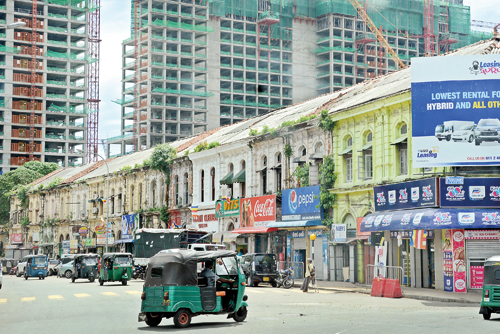Don’t bulldoze our colonial shop houses into oblivion

In need of protection: The row of Shop House buildings on Justice Akbar Mawatha, Slave Island. Pic by M.D. Nissanka
The last of the Shop House- style buildings in Slave Island is facing demolition. Once the headquarters of the prestigious firm of H.W.Cave & Co which from 1877 was the country’s leading publisher and printer of exquisitely bound antiquarian travel books on Sri Lanka, this remarkable gem of colonial architecture and century-old heritage building on Justice Akbar Mawatha, Slave Island Colombo 2 is under threat.
Although now run down and looking worn, it was a landmark building in the last century in the period from 1918 onwards.
The building’s architectural style is unique. This two-storeyed block that lines the road for almost 200 yards was one of the earliest examples of the building design style of offices, shops on the ground floor and residential spaces on the upper floor. These so called Shop House buildings formed a part of the urban fabric of inner city centres and were constructed in most of the Tropical Asian regional capitals such as Mumbai, Chennai, Colombo, Singapore, Penang and Rangoon. Many of them have crumbled to heavy hammer blows from bulldozers- a few have survived in Singapore at Emerald Hill off Orchard Road. These rare examples of buildings of the colonial period are not only protected by strict building regulations but are also the most expensive spaces for use as apartments and shops.
Henry William Cave was both the founder and the firm’s owner. He came out here as the Private Secretary to Bishop Copleston. In 1879 with the assistance of the Bishop and friends in the civil service, Cave opened a small bookshop, which largely included Bibles and religious tracts. By 1884 the firm now titled H.W.Cave & Company had become a full-fledged firm printing, publishing and producing exquisitely bound and gilded books, which were mainly authored by Cave himself on travel within Sri Lanka by road and rail.
After occupying a building sited in Queen’s Street (now the Central Bank offices) for almost 37 years they moved to the premises in Slave Island – the present building under discussion to establish the printing presses.
The firm’s main offices at the same time moved to premises in Gaffoor Building in Prince Street in Fort. Cave died in 1913 in England aged 59.
The present block which was leased by Cave was originally constructed by the wealthy entrepreneur and leading landowner in Colombo C. H.De Soysa.
In his wonderfully written book on the business and finance firms of Sri Lanka in the 1940s, Sir Thomas Villiers has this comment of the premises occupied by H.W.Cave & Co in Slave Island-
“On moving into its new premises of which it occupied three fourths of the downstair portion an existing light luncheon and afternoon tea establishment in the centre court of the building, was taken over, and with the introduction of young and ambitious partners, many new lines of businesses were added.”
In 1980, Professor Ronald Lewcock recorded the original listing of heritage buildings in Colombo, but these two storeyed buildings in Slave Island were not recorded due to an oversight. When I contacted him this week he believed that this was one of the best representative buildings of its type and needs all the protection and should not be demolished.
The Department of Archaeology on being re-appraised of the critical situation has shown considerable concern as this is a protected building – now that is more than a century old, and deserves to be protected. The Acting Director General P.B.Mandawala, Department of Archaeology assured the Sub Committee of the National Trust in which Dr. Roland Silva (former President National Trust) and the writer was present last Tuesday, May 1- that suitable action will be taken to save this monument.
There are efforts underway to restore this building to its former condition and discussions are taking place with the tenants.
However, we are concerned that the fate of the Castle Hotel may befall these buildings as well. In 2016, the Archaeological Department conducted a survey of the Castle Hotel and adjoining building site and designated it as a property of historical interest, recommending that it should be preserved as a national monument on account of it being a prime example of British colonial architecture.
A copy of this report was sent to the Chairperson of the Urban Development Authority (UDA) with instructions that whatever renovations the Tata Company does, it could not make structural changes to these buildings. Unfortunately the building was demolished overnight in spite of all the heritage laws laid down.
The story goes that during the 1920s and 1930s, the premises of H.W.Cave & Company was considered one of the most fashionable addresses in Colombo and it was here that the aspiring national political figures, such as D.R. Wijewardene, D.S. Senanayake and Oliver Goonetilleke, met to discuss the constitutional reforms that led to Sri Lanka’s independence in 1948.With such historic links we hope the Prime Minister will give his unstinting support and advise the necessary state department to intervene in this matter to save this historic building.
(Ismeth Raheem is a Chartered Architect, art and architectural historian who has published several articles and books on Colombo’s heritage buildings. He is also the Vice President of the National Trust of Sri Lanka)


